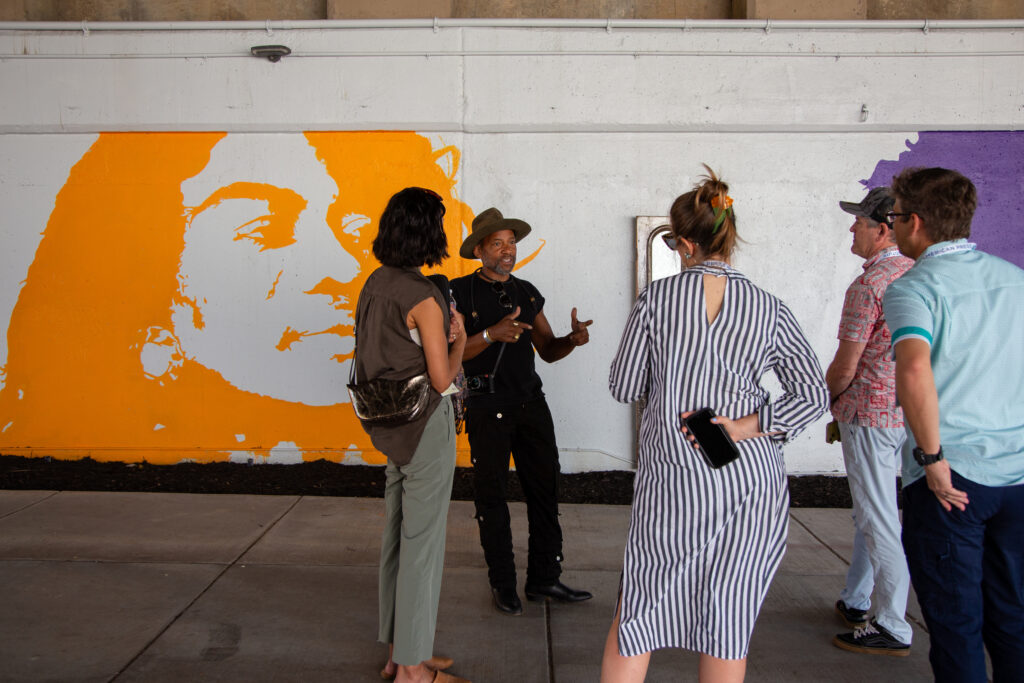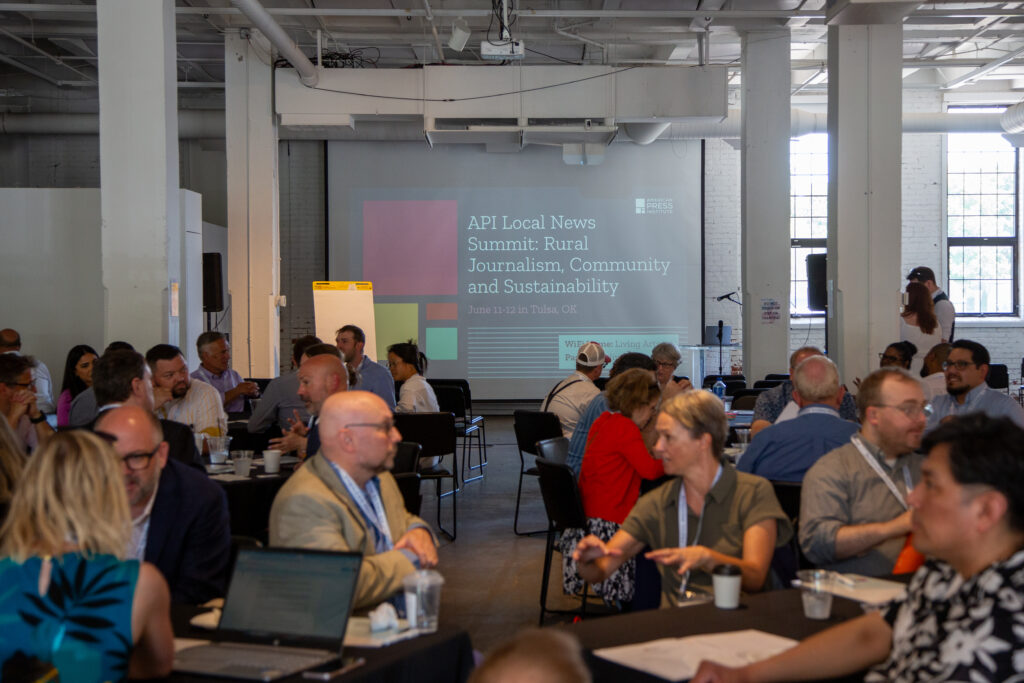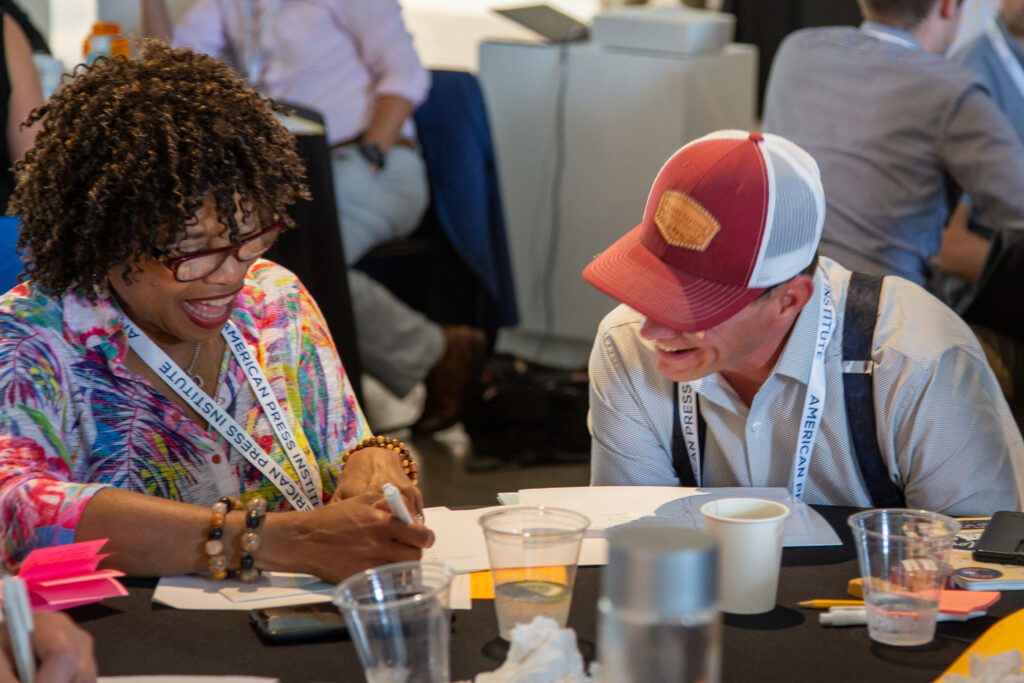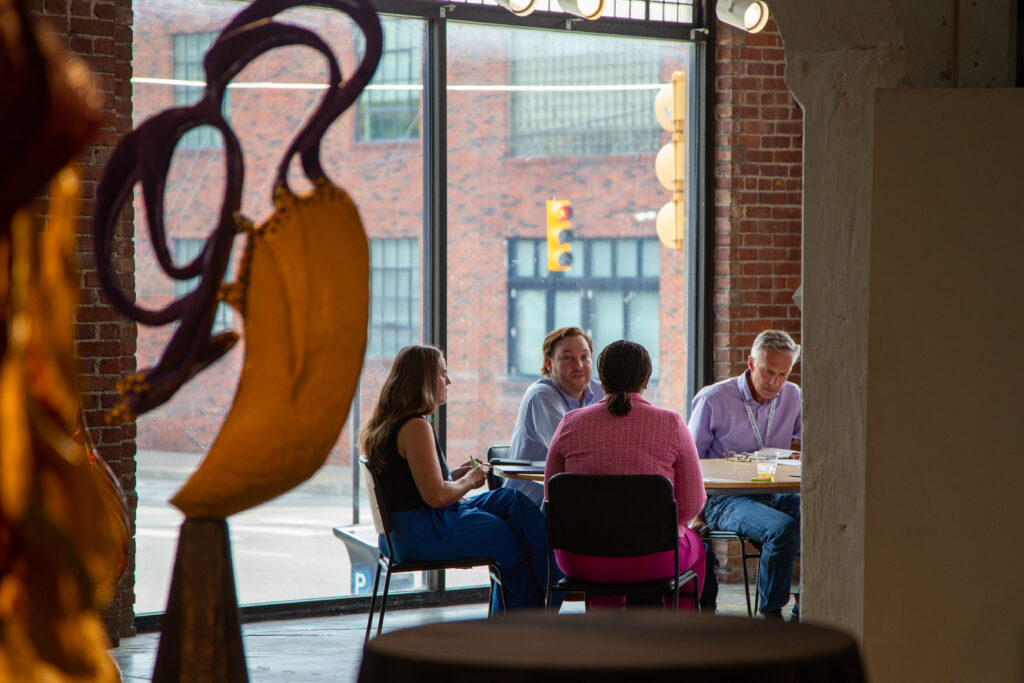API helps local and community-based media help all people have the information they need to make decisions and thrive. We think embracing the role of convener is an important step.
Why convenings? They enable journalists to engage directly with the communities they cover and provide a platform to explore community concerns, hopes, needs and talents. Bringing reporters and residents together to listen and learn builds trust for news outlets while forging the social connections that help communities thrive.

Marlon F. Hall tells summit attendees how community input brought his mural project to life in Tulsa.
At a recent summit for rural-serving news leaders, we talked about all kinds of convenings: news and brews, candidate forums, solutions circles, community meals, reporter office hours, pop-up cinemas, subscriber-exclusive meetups and more. We also discussed the importance of facilitating them in ways that create connection and belonging. But what might that look like?
Here’s a roundup of strategies I heard during the summit, and a few from my own experience facilitating gatherings in rural communities across the country. Although these practices bubbled up in conversation with rural leaders and organizers, they’ll work just as well in suburban and urban spaces. And they are curated for newsrooms that have had less experience planning and implementing events.
Create a welcoming space
When participants feel comfortable and welcome, they are more likely to engage in activities, which helps to ensure the success of your event.
 At the Rural News Summit, API modeled how to create that sense of hospitality from the jump by having greeters warmly welcome us at a sign-in table, orient us to the space and highlight key information in the program. Then they offered us food and refreshments and invited us to join a cocktail table with others to nosh and get to know one another.
At the Rural News Summit, API modeled how to create that sense of hospitality from the jump by having greeters warmly welcome us at a sign-in table, orient us to the space and highlight key information in the program. Then they offered us food and refreshments and invited us to join a cocktail table with others to nosh and get to know one another.
These small details can really make a difference. In rural communities, where I’m often an outsider, I try to personally say hello and shake everyone’s hand as they go from the sign-in table to their seat. It’s amazing how that one simple gesture helps folks feel appreciated and welcome. When possible, I recruit community members to serve as table hosts to greet people as they arrive at a table and facilitate introductions. This helps people bond and feel part of a group.
Other ideas to consider when setting up
- Set up the room with colorful decorations or appropriate music to help foster a warm, lively environment
- Ensure the room temperature is comfortable
- Provide a variety of comfortable seating
- Make sure people can hear one another
- Screens, posters and other visuals should be easy to see from different parts of the room
👉🏼Try this at home: Put cush balls, Legos, pipe cleaners or other toys on tables. They add a touch of fun, interactivity and relaxation (event topics or large groups can sometimes be overwhelming, and having something to fidget with can help reduce stress). They also help create an inviting and social atmosphere as people play with or share them. Toys are especially great for an all-ages event or when it’s likely that parents will be showing up with kids in tow.
Establish guidelines
If your event involves examining issues or exploratory conversations, setting group agreements helps create an atmosphere where all participants feel more comfortable and motivated to engage with each other. This is especially true for events aimed at bridging divides or exploring complex issues. For people who have experienced trauma or are wary of journalists’ motives, creating these agreements demonstrates that you are attentive to their concerns as well as invested in determining how to support their individual and collective success.
Use participant input to build group agreements
- Establish agreements by inviting participants to respond to an idea like: “What would help you feel more comfortable and motivated to participate in this conversation?”
- Suggest guidelines such as “Share the lessons, but leave out details” and “Be critical of the process, not of individuals or groups,” and then invite input.
- At candidate forums, consider implementing a guideline of no national politics. Instead, stress that the candidate forum will focus on the local community.
- Maintaining guidelines is crucial for keeping people feeling safe and motivated to share their ideas.
In rural communities, I’ve had a lot of success adapting these six conversation agreements used by the organization The Living Room Conversation. The National Equity Project also provides some great resources for creating guidelines and implementing them.
Creating guidelines is one thing, but maintaining them is another.
“My advice for others who want to try this is that going into it, know that you’re going to have to be the heavy,” says Brittany Schock, engagement and solutions editor at Richland Source in Ohio. “Think about how you want to approach that. Be really confident and assertive. Because you’re the boss, this is your space, and it is up to you to make it a safe space for everyone who’s present.”
👉🏼Try this at home: If you are bringing folks together around a touchy subject or think people will be hesitant to speak up (or might dominate the air space), pass out pens and index cards and invite participants to write down one guideline for having a respectful and useful conversation. Collect and redistribute the cards, inviting attendees to read someone else’s idea. Then ask the group to identify common themes that they are willing to abide by.
Make time for building personal connections
 Most of us are usually trying to pack a lot into our convenings, so it’s tempting to welcome folks and then jump right into the main activity you have planned.
Most of us are usually trying to pack a lot into our convenings, so it’s tempting to welcome folks and then jump right into the main activity you have planned.
But if we are trying to build a sense of connection and belonging among attendees at our events, then we have to make time for people to get to know each other in the run-of-show.
Three ways conveners build connections among community
- Quick intro activities to engage attendees. Max Resnik, the Director of Network Services at City Bureau, invites participants to introduce themselves, giving them “a chance not just to say who they are and what their job is, but something that they love or care about within their community, what they wish somebody else would know about it.” Or he might invite audience members to share what motivated them to attend the gathering, surfacing their hopes, curiosities or concerns.
- Use artifacts and storytelling to relate in new ways. Marlon F. Hall, a Tulsa-based artist and visual anthropologist, hosts community dinners and invites people to bring a pocket-sized artifact that represents their personal cultural heritage to the gathering. Over a shared meal, he encourages attendees to show their artifact and tell the story that’s connected to it.
- Let attendees tell their own stories based on your reporting. At a convening I organized on rural suicide, participants listened to our healthcare reporter and managing editor share statistics and stories that brought the data to life. I then gave participants time to share what resonated with them, and had them share what came up in conversation. In feedback,, the majority of attendees said what they appreciated most was having the chance to talk with each other about this taboo topic. They reported having a better understanding of the issues as well as how it’s impacting their community.
👉🏼Try this at home: In rural communities, most people who show up at a convening already know each other and often have a long history together. Consider using personal story sharing prompts that will help them learn new or surprising things about one other like: what’s something about you that most people don’t know? If you came with a warning label, what would it say? If you were entering a wrestling ring, what would be your theme song? What’s your favorite item at the local dinner or one tool you can’t live without? The one I use that works every time is asking people to finish this sentence: If you really knew me, you’d know…
Make it interactive
 Structured time for interaction allows people to connect and build relationships. That’s why it’s helpful to include activities or events that encourage participation.
Structured time for interaction allows people to connect and build relationships. That’s why it’s helpful to include activities or events that encourage participation.
At the summit, API modeled this by having people “pair and share” on the kind of convening work they do currently and the kind they’d like to be doing differently in the near future. This “from-to” activity helped us meet someone new, voice our aspirations and be heard by others. They did this just 15 minutes into the convening as a springboard for a presentation on convening skills and practices.
Activities to connect participants
- Icebreakers
- Q&A sessions
- Live polls
- Breakout groups
- Networking opportunities
- Paired walk-and-talks
👉🏼Try this at home: Offering various ways to engage allows everyone to participate in a way that feels comfortable to them. Provide materials for drawing or writing, and encourage creative activities.
End with a purpose
There’s an art to bringing convenings to a close. You’ll want to recap goals and accomplishments as well as present some next steps.
“Even if it’s just a speaker series, you can share upcoming events, invite people to check your website, become a member or tell them that they’re going to see reporting following up on this,” said Drew Himmelstein, head of community engagement and solutions journalism at Islandport Media.
You’ll also want to conclude in a way that energizes participants. Bring the entire group together toward the end of the event to reflect on the experience they’ve just had. Elicit common themes and discoveries to identify patterns, share new knowledge, and build a shared understanding of the kind of community that they want to live in.
👉🏼Try this at home: Have attendees fill out a note or postcard to themselves listing something they learned at the event, and, if applicable, something they want to try in their own lives. Mail them the postcard a month after the convening, or use their reflections in targeted follow-up communications.
Create pathways for continued engagement
Post-event, you’ll want to keep the momentum going. You can do that by sending participants a brief thank-you note along with a survey to gather feedback and more ways to engage with your organization, like signing up for your newsletter or attending upcoming events. Depending on your convening, you might also include event highlights or notes generated during the gathering. If your organization produces content based on the event, be sure to send participants links to the story.
Designing convenings for connection and belonging can seem like a heavy lift. But as Deborah Tien, the founding steward of Common Agency, observed: “As long as you’ve done some prep work to understand what the purpose is, and as long as you’re working towards that purpose and having fun, people will get what they need out of your convening.”
👉🏼Try this at home: In every rural community I’ve worked in over the past 15 years, I’ve found that many people turn to Facebook groups for their news and information. Consider creating a Facebook group for event attendees — especially if it’s a group that will convene multiple times — or engage with an established community group on learnings that emerged from the event.
You might also be interested in:
The Houston Chronicle created small-scale experiments that tested how strategically work with a creator while navigating potentially thorny issues around ethics, control and impact. In this series, they walk you through what they did.
Every community has a commons — a park, a library, a garden — a shared space that only thrives when people care for it together. Our local information ecosystems are no different. At our recent Local News Summit, we asked the room: What does it mean to be gardeners, guards and stewards of the local information commons?
We know psychological safety might feel like a ‘nice to have,’ but what if the failure to create that safety is silently stalling your best ideas and alienating your next generation of leaders?



